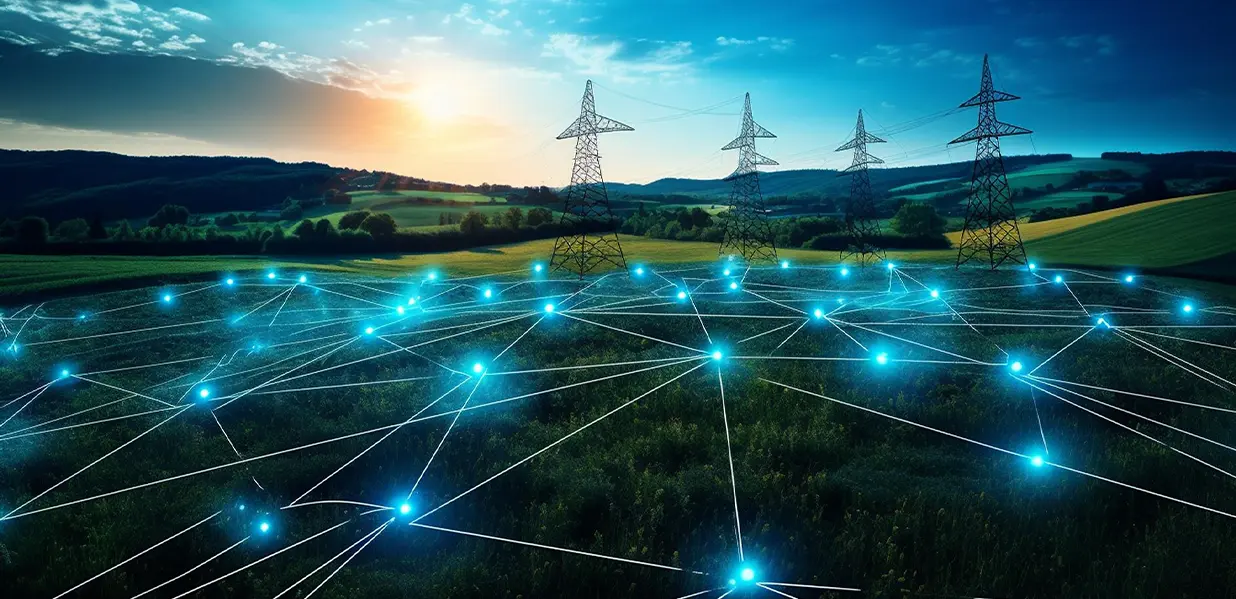IoT and 5G: A Dynamic Duo for Advancing Smart Grids and Automated Energy Systems
Imagine a world where your toaster and street lights can communicate, making smart decisions to save energy and simplify life. Now, picture super-fast internet enabling these devices to talk to each other instantly, no matter their location.
It might sound like something out of a sci-fi movie, but this vision is becoming our reality through the dynamic duo of technology: IoT (Internet of Things) and 5G.
In this blog, we're diving deep into how IoT and 5G are joining forces to revolutionize our energy systems, making them smarter, cleaner, and more efficient than ever. We'll uncover the wonders of smart grids that ensure our lights stay on seamlessly and automated energy systems that function like autopilot for our electricity needs.
We'll also take a closer look at how remote energy facilities are managed from miles away, optimizing every ounce of energy.
So, get ready for an exciting ride! Whether you're a tech aficionado or simply curious about the future of energy, this exploration of IoT and 5G is crafted to be enjoyable, enlightening, and straightforward.
Prepare to discover how these technological marvels are paving the way for a brighter, more sustainable future for everyone.
The Power Team: IoT and 5G
When IoT (Internet of Things) and 5G come together, they form a powerful, smart, and efficient energy system. This combination turns smart grids into proactive players that can anticipate and adapt to changes in energy needs and availability instantly.
This doesn't just make our electricity supply more reliable; it also boosts the use of renewable energy sources such as wind and solar, leading to more eco-friendly energy consumption.
Additionally, automated energy systems gain reliability and efficiency. Thanks to the instant data and analytics provided by IoT and 5G, these systems can fine-tune energy distribution, cut down on waste, and even foresee maintenance needs to prevent failures.
This translates to fewer interruptions, reduced expenses, and a smaller environmental impact.
Imagine IoT and 5G as a superhero team working for us, battling energy waste and leading the charge toward a more sustainable world. As their partnership strengthens, our energy systems are set to become smarter, more agile, and eco-friendlier.
The energy future is not just about producing more power but doing it in cleverer ways. Thanks to IoT and 5G, we're already starting to see this future take shape.
Smart Grid Technology: The Brainy Energy Networks
Smart grids represent a significant leap forward in our approach to energy management. By leveraging advanced technologies, they transform traditional electricity networks into dynamic, interactive systems that offer numerous benefits:
- Intelligent Monitoring: Utilizing an array of sensors and smart meters, smart grids provide a real-time overview of energy flow, demand, and supply across the network. This comprehensive visibility allows for more precise and efficient management of resources.
- Two-Way Communication: Unlike the one-way interaction in conventional grids, smart grids facilitate bidirectional communication. This means information flows not only from the energy provider to the consumer but also from the consumer back to the provider, enabling a more responsive and adaptable energy service.
- Automated Adjustments: Smart grids use real-time data to automatically adjust and balance the supply of energy, enhancing efficiency by reducing waste and ensuring that energy distribution meets current demand levels.
- Incorporating Renewables: They are adept at integrating renewable energy sources, such as solar and wind power. Smart grids manage the inherent variability of these sources, ensuring their energy is effectively distributed and utilized within the grid.
- Predictive Maintenance: Through continuous analysis of network data, smart grids can anticipate maintenance and repair needs before failures occur, minimizing outages and ensuring a more reliable energy supply.
- Enhanced Resilience: Smart grids are designed to be more resilient to disruptions, including natural disasters and technical outages. They can isolate and manage issues swiftly, rerouting power to maintain service wherever possible.
- Consumer Empowerment: With smart meters and home energy management systems, consumers gain greater insight and control over their energy usage, enabling them to make informed decisions to save energy and reduce costs.
- Energy Efficiency: By optimizing the generation, distribution, and consumption of electricity, smart grids contribute to overall energy efficiency. This not only leads to cost savings but also supports environmental sustainability by reducing the carbon footprint of energy systems.
Also Read: The Symbiosis of 5G and Smart Grid Technology: A New Era for Energy Management
Automated Energy Systems: The Self-Driving Cars of Electricity
Automated energy systems are revolutionizing the energy sector by introducing levels of efficiency, reliability, and sustainability previously unattainable. Here's a closer look at their key features:
- Self-Optimizing: Analogous to how self-driving cars select the most efficient routes, automated energy systems use algorithms to continuously analyze data, optimizing energy distribution and consumption for maximum efficiency and sustainability.
- Real-Time Adjustments: Similar to an autonomous vehicle's instantaneous reactions to changing road conditions, these systems dynamically balance energy supply with demand, ensuring optimal performance of the grid at all times.
- Predictive Maintenance: By utilizing data analytics to forecast maintenance needs, automated energy systems can preemptively address potential issues, reducing the likelihood of outages and failures—much like self-driving cars navigate to avoid obstacles.
- Integration of Renewable Sources: They adeptly incorporate renewable energy sources into the grid, managing the variability of solar and wind energy to maintain stability without compromising the grid's performance.
- Energy Storage Management: Automated systems smartly manage the storage and release of energy, much like deciding when to store excess energy for later use, thereby optimizing for both cost and demand fluctuations.
- User Participation: Through demand response programs, consumers become active participants in the energy system, adjusting their usage in response to signals from the grid, akin to passengers selecting destinations in self-driving cars.
- Enhanced Security: These systems deploy advanced security protocols to safeguard against cyber threats, ensuring the integrity and reliability of the energy supply—comparable to the sophisticated safety features found in autonomous vehicles.
- Cost and Energy Savings: The culmination of these features results in significant reductions in energy waste and cost, delivering direct benefits to consumers and businesses while also contributing positively to environmental sustainability.
Also Read: 12 Key Advantages of Implementing 5G in the Energy Industry
Remote Energy Facilities: Keeping an Eye from Afar
Remote energy facilities, such as wind farms, solar arrays, and hydroelectric plants, are increasingly managed through advanced technology, allowing for efficient operation without the need for constant physical presence. Here's a breakdown of how these facilities are monitored and managed from afar:
- Real-Time Monitoring: Utilizing advanced sensors and cameras, operators can receive live data on the facility's output, environmental conditions, and equipment health, enabling quick identification and response to any operational issues.
- Automated Control Systems: These systems allow for remote adjustments to operational parameters—like changing the orientation of solar panels or the pitch of wind turbine blades—to maximize energy production based on real-time environmental data.
- Predictive Maintenance: Data analytics enable the prediction of potential equipment failures before they occur, allowing for preemptive maintenance scheduling that minimizes downtime and maximizes efficiency.
- Remote Diagnostics: Technicians can remotely diagnose and troubleshoot issues using data transmitted by the facility's sensors, significantly reducing the necessity for on-site visits and allowing for quicker responses to problems.
- Cybersecurity Measures: Secure communication protocols are essential to protect the exchange of data and control commands between the remote facility and its control center, safeguarding against cyber threats and ensuring the reliability of energy production.
- Integration with the Grid: These facilities are seamlessly integrated into the broader energy grid, enabling them to adjust production in response to current energy demands and grid conditions, enhancing overall grid stability and efficiency.
- Environmental Monitoring: Remote sensors also monitor the environmental impact of these facilities, ensuring operations comply with regulatory standards and strive to minimize their ecological footprint.
- Accessibility and Efficiency: Drones and satellite imagery provide additional layers of monitoring, especially useful for facilities in extremely remote or inaccessible areas, ensuring comprehensive oversight and facilitating easier management of these critical energy sources.
Also Read: 5G’s Contribution to Remote Energy Production Optimization
Conclusion
As we explore the world of smart grids, automatic systems for managing energy, and controlling energy facilities from far away, it's clear that the team-up of IoT (Internet of Things) and 5G technology is a big deal.
It's not just a new trend; it's changing the way we deal with energy. IoT and 5G work together to gather data, think it over, and then make smart decisions quickly. This means we're moving towards a future where our energy is more dependable, doesn't waste as much, and is better for the planet.
IoT and 5G are about more than just neat gadgets and super-fast internet. They're helping build a strong energy system that can take care of the needs of more and more people while making sure our Earth stays healthy. Thanks to smart grids and automatic energy management, we're learning how to use every bit of energy better.
We're getting really good at using energy from the sun, wind, and other renewable sources in our everyday lives. This helps us cut down on pollution and take better care of the environment.
But, heading towards a smarter, cleaner energy future has its tough spots, but there's also a ton of chances for us to do better. With IoT (Internet of Things) and 5G, we've got the keys to really making the most out of our energy, setting the stage for a brighter and cleaner world for everyone down the line.
Are you pumped to lead the charge in changing how we use energy? Get in touch with us today to find out how our software development services can boost your use of IoT and 5G tech. Let's join forces to power up the future.
Schedule a call with our expert to transform your energy systems with IoT and 5G!
 June 27, 2025
June 27, 2025
 Balbir Kumar Singh
Balbir Kumar Singh
 0
0
 June 13, 2025
June 13, 2025
 Balbir Kumar Singh
Balbir Kumar Singh
 0
0
 May 30, 2025
May 30, 2025
 Balbir Kumar Singh
Balbir Kumar Singh
 0
0
 June 27, 2025
June 27, 2025
 Balbir Kumar Singh
Balbir Kumar Singh
 0
0
 June 13, 2025
June 13, 2025
 Balbir Kumar Singh
Balbir Kumar Singh
 0
0
 May 30, 2025
May 30, 2025
 Balbir Kumar Singh
Balbir Kumar Singh
 0
0
 June 27, 2025
June 27, 2025
 Balbir Kumar Singh
Balbir Kumar Singh
 0
0
 June 13, 2025
June 13, 2025
 Balbir Kumar Singh
Balbir Kumar Singh
 0
0
 May 30, 2025
May 30, 2025
 Balbir Kumar Singh
Balbir Kumar Singh
 0
0









Leave a Reply